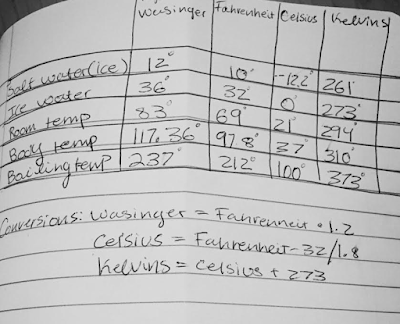Ms. Bowser
Chemistry
January 24, 2016
I am in high school, I don't have any degrees
Purpose: To use a thermometer, learn how it works, and observe how changes in temperature effect the thermometer.
Materials:
Part I:
- Small glass vial
- (3) 250 mL beakers
- Hot plate
- Ice
- Ice water
- Salt
- Small metric ruler
- Ethylene glycol (antifreeze) (25 mL in each thermometer
- Rubber Septum or rubber stopper
- Plastic straw
- test tube holder, wire
- Permanent marker
Part II:
- 250 mL beakers (3)
- Ice
- Test tube holder, wire
- Hot plate
- 10 mL graduated cylinder
Safety:
Hot Plate: Be sure when using the hot plate (to boil water) to not directly touch the heated surface of the hot plate as burns may result.
Ethylene Glycol (Antifreeze)( HOCH2CH2OH): Being exposed to this substance for large amounts of time can result in death. Can be harmful/ irritating to skin and eyes and permeate. Hazardous for inhalation (Material Safety Data Sheet).
Background:
The Thermometer is used to measure temperature and there two commonly used units of measurement: Celsius and Fahrenheit. Celsius units were invited by Anders Celsius, an astronomer (The Physics Classroom). On the Celsius scale, Water boils at 100 degrees and freezes at 0 degrees. Physicist Daniel Fahrenheit invented the other commonly used unit of measurement for temperature, degrees Fahrenheit (The Physics Classroom). In degrees Fahrenheit, water freezes at 32 degrees and boils at 212 degrees.
For creating a scale for a thermometer, pick a number for a certain temperature (i.e. 6 degrees for water freezing and 103 degrees for water boiling).
Typically, a thermometer consists of a liquid inside of a clear tube. As temperatures rise, so does the liquid inside the thermometer and when the temperature falls, the height of the liquid inside the tube falls as well (Mary Bellis). This occurs because when higher temperatures occur, the molecules become farther apart and the only way to create more room for the molecules to move about is by increasing volume and to do that, the liquid must expand upwards (How Things Work). When the temperature falls, the molecules come closer together (How Things Work).
Questions from 3.4
- The rising and falling of the Ethylene glycol in the tube.
- The temperature change. The density is changing and the volume . The higher temperatures forces the liquid in the tube to expand and travel upwards in the tube.
B) The room temperature is 82.8 degrees Wasinger or 69 degrees Fahrenheit. To convert Fahrenheit to Wasinger: Multiply the degrees in Fahrenheit by 1.2.
Procedure:
Part I:
- Put the thermometer in the varying heat conditions (there are five total heat tests for the thermometer) and record where the thermometers' liquid stops climbing by marking it with a permanent marker.
- Measure the temperature with the thermometer at room temperature, when it is placed in a hand (body temperature), when it is placed in boiling water, when it is placed in ice water, and when it is placed in a mixture of ice water and salt.
Part II:
- Fill a 250 mL beaker with 200 mL of water. The water should be heated to 80 Degrees Celsius. In another 250 mL beaker, put in room temperature water. Put ice into the last beaker.
- Use the test tube clamp to place the 10 mL graduated cylinder into the hot water beaker with the opening of the test tube almost touching the bottom of the beaker. Record what you observe.
- Remove the 10 mL graduated cylinder from the hot water and place it into the room temperature water following the same method as used with the hot water. Record observations.
- Add the ice from the third beaker into the room temperature water using the same method used for the previous two beakers. Write down any observations.
- Changes were observed during the lab due entirely to the change in temperature at each of the individual stations in part I. In part II, the changes were due to the varying temperatures of the water tested.
Discussion of error, In this lab, there was no error between the conversions from Degrees Wasinger to Fahreinheit, Celsius and Kelvins.
Conclusion:
In conclusion, the results for this lab are as follows:
Part I:
Condition Centimeters Degrees Wasinger
Salt Ice Water(general chemistry online) 7.5 12
Ice Water 9 36
Room Temp 11.9 83
Body Temp 14 117.3
Boiling Temp 32 237
Part II:
Hot Beaker: Condensation, steam bubbles
Room Temperature beaker: Nothing occurred
Iced beaker: Bubble inside graduated cylinder
- The temperature for the conditions tested were as to be expected. However, part II of the lab had differently anticipated results. A huge bubble formed inside the graduated cylinder in the last test with the ice water.
Questions:
Citations:
General Chemistry Online. Why isn't the lowest possible temperature for salt/ice/water mixture 0?. (n.d). Retrieved from: http://antoine.frostburg.edu/chem/senese/101/solutions/faq/zero-fahrenheit.shtml
How Things Work. How does the thermometer work. (n.d.). Retrieved from:http://www.energyquest.ca.gov/how_it_works/thermometer.html
Mary Bellis. The history of the thermometer. Retrieved from: http://dwb4.unl.edu/chem/chem869m/chem869mlinks/inventors.about.com/science/inventors/library/inventors/blthermometer.htm
Material Safety Data Sheet. Ethylene glycol MSDS. In: Sciencelabchemicals.com. Chemicals and laboratory equipment. Retrieved from: http://www.sciencelab.com/msds.php?msdsId=9927167
Purdue Owl. Joshua M. Paiz, Elizabeth Angeli, Jodi Wagner, Elena Lawrick, Kristen Moore, Michael Anderson, Lars Soderlund, Allen Brizee, Russell Keck. 2015-03-27 01:19:35. Retrieved from: https://owl.english.purdue.edu/owl/resource/560/10/
The Physics Classroom. Temperatures and Thermometers. (n.d.) Retrieved from:http://www.physicsclassroom.com/class/thermalP/Lesson-1/Temperature-and-Thermometers



No comments:
Post a Comment